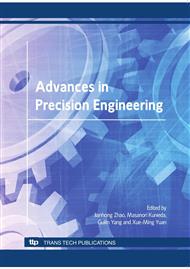p.242
p.247
p.258
p.263
p.268
p.272
p.277
p.282
p.287
High Spindle Speed Wire Electrical Discharge Grinding Using Electrostatic Induction Feeding Method
Abstract:
This paper describes machining characteristics of high spindle speed WEDG using the electrostatic induction feeding method. In this method, non-contact electric feeding allows the workpiece rod to be rotated at a high speed of up to 50000rpm. Since the temperature rise on the workpiece surface is low, the material removal rate was two times higher and the surface roughness was also improved compared to the normal RC discharge circuit where the rotational speed was 1000rpm at the highest due to contact electric feeding using a brush. Furthermore, micro rods thus prepared were used as tool electrodes to machine micro-holes with the same rotation speed of 50000rpm. It was found that smaller gaps and better straightness can be obtained due to the high flushing efficiency at the high spindle speed.
Info:
Periodical:
Pages:
268-271
Citation:
Online since:
September 2010
Authors:
Price:
Сopyright:
© 2010 Trans Tech Publications Ltd. All Rights Reserved
Share:
Citation:


